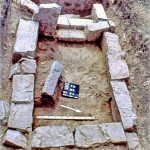Colonization
On the insidebospor Сolonization of peripheral Areas of the Asiatic Bosporus
The Greek colonization ‒ the process of development (settlement), the new easy to natural climatic and strategic respects, rich mineral and human resources areas ‒ covers a whole historical epoch in the history of the Northern Black Sea.
Demographic growth in the Black Sea colonies (due to an arrival of new people and a result of the natural growth), as well as, apparently, the economic (production, trade and exchange) activities of Greek Bosporian people led to quality changes: they began an active development of the surrounding territories and economic Peripherals of antique centers – khora (suburbs) were getting formed and expanding. A special role in this process was played by the Bospor ruling elite. Relying on the testimony of ancient writers, in particular, on the basis of the foundation of Bosporus of Cimmerida by the tyrants (Ps.-Skymn., 896) and Sindhi Harbor (Ps.-Skymn., 888) by the Greeks who came from the near by the territory, S.A. Zhebelev described this process as a secondary, «insidebospor» colonization. Success of this term is confirmed by its use by the leading researchers of the history of the Bosporus state (D.B. Shelov, Y.G. Vinogradov et al.).
Inside Bospor colonization can be called as late archaiс era, the end of the 6th century ‒ the beginning of the 5th century BC. Despite the complexity and diversity of manifestations of this process, both on the European Bosporus (North-Eastern Crimea) and on the Asian side, the Kuban’ and the Don regions, there is no doubt that the most significant impetus to its development had been set by political events: at the turn of 5th‒4th centuries BC. ‒ during the formation of a united territorial state by Levkon; at the turn of the 4th‒3th century BC ‒ at the moment of maximum expansion of the boundaries of the Bosporus state by Eumelos; in the first century BC ‒ in the period of strengthening of the central government by Asander.
Completion of the insidebospor colonization take place at the turn of the eras, when clearly gaining momentum is diametrically opposite in content, but not the least, a long and varied than the insidebospor colonization, the process of barbarization of the Bosporus. Its basis was the massive penetration of representatives of Scythian-Sarmatian and Meotic-Sarmatian tribes in the ancient centers of the northern Black Sea coast.
To the south-east of the Asian Bospor the Greek settlements make their appearance as early as the archaic era: on the coast of Tsemes (Bata-village) and Gelendzhik (the settlement Toric) bays, but they had not evidently become great urban centers.
At the turn of the 4th‒3th centuries BC an interest in this region in the Bosporus had clearly manifested. A natural border of the Bospor influence in the Hellenistic period had set along the ridge Navagir (at the end of 5th‒4th centuries BC and along the ridge Semisam). The development of this area clearly involved the Zakuban’ population. The system of settlement at this stage duplicates the native one.
The new phase of the process of colonization of the southeastern periphery starts the Early Roman period: the system of fortified tower estates puts under its control the entire Abrau peninsula.
Thus, large areas in the east and southeast of the Asian Bosporus are subordinated and mastered pretty late – at the turn of the IV-III centuries. BC. Judging by the variety of sources, almost since the creation of the Bosporus territorial state at the end of the 5th century BC the colonization process had been under the control of the rulers of Bosporus, i.e. had got the rank of the state policy.
(Aleksey A. Malyshev)



